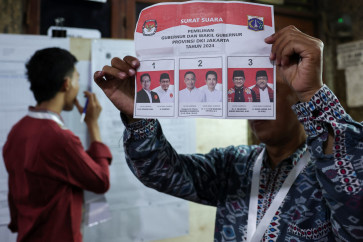Popular Reads
Top Results
Can't find what you're looking for?
View all search resultsPopular Reads
Top Results
Can't find what you're looking for?
View all search resultsIndonesia foreign debt rises as govt borrows from multilateral organizations
Indonesia’s foreign debt rose by the end of August as the government borrowed funds from multilateral organizations to cover the country’s fiscal deficit, while businesses borrowed funds for investment.
Change text size
Gift Premium Articles
to Anyone
Indonesia’s foreign debt rose by the end of August as the government borrowed funds from multilateral organizations to cover the country’s fiscal deficit, while businesses borrowed funds for investment, Bank Indonesia (BI) announced Thursday.
Indonesia’s external debt, which includes government and private-sector borrowings, was recorded at US$413.4 billion in August, up 5.7 percent year-on-year (yoy), central bank data showed.
The government’s foreign debt rose 3.4 percent yoy to $200.1 billion in August, according to the central bank. Meanwhile, overall public-sector debt, which aside from that of the government also includes that of the central bank, amounted to $203 billion.
The rise in the government’s foreign debt was “driven by the partial withdrawal of loan commitment from multilateral organizations to support Indonesia’s COVID-19 pandemic handling and the national economic recovery program,” BI said in a statement.
The government has earmarked Rp 695.2 trillion ($47.25 billion) to finance pandemic handling and support the economy, which is expected to widen the budget deficit to 6.34 percent of GDP. Several multilateral organizations, such as the World Bank, Asian Development Bank and the Asian Infrastructure Investment Bank, have committed to providing loans for the country.
Meanwhile, private-sector foreign debt, which includes borrowings by state-owned enterprises, grew at a faster rate than government debt at 7.9 percent in September to $210.4 billion.
“Most of the external debt was used to finance corporate investment activities,” the central bank said, adding that 77.5 percent of the debt came from four sectors, namely mining, manufacturing, financial services and insurance, as well as electricity and gas procurement.
The central bank deemed the overall external debt level to be healthy, with the foreign-debt-to-GDP ratio recorded at 38.5 percent at the end of September, up from 38.2 percent in the previous month. Long-term loans account for 89 percent of the current outstanding debt.
“The external debt [use] will be optimized to support development financing and stimulate economic recovery by minimizing risks that may affect macroeconomic stability,” it added.
According to the International Debt Statistics report published by the World Bank on Monday, Indonesia’s debt is one of the highest in the world among developing nations.
According to the report, Indonesia’s debt reached $402.08 billion by the end of last year, the seventh-highest among emerging economies.
“The government’s debt only comprised 29.8 percent of the total debt in the World Bank’s data, and the rest came from the private sector,” said the special adviser to the finance minister, Masyita Crystallin, adding that government debt remained manageable.
“Before the coronavirus pandemic, the government used the debt for strategic projects to close the infrastructure gap and reduce logistics costs, which could ultimately boost the country’s economic growth,” she went on to say.










